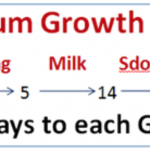Texas Sorghum, Ethanol find NASCAR Spotlight—Today, Austin Wayne Self a Texas native and NASCAR Camping World Truck Series driver will attend the State Fair of Texas to kick off the three-week festival in Dallas. As ethanol continues to have a larger presence on the NASCAR stage, Self was drawn to a partnership with Go Texan, an organization that proudly promotes the use of ethanol in fuel. Last year, Texas Sorghums worked with TDA and Go Texan to implement the Biofuels Infrastructure Partnership, a $17 million project placing 782 additional E15 blender pumps at fueling stations across Texas. Self will make appearances at the Go Texan Pavilion with his NASCAR truck, which uses an E15 blend and features Texas Sorghum’s logo through October. To read the entire article, click here.

Austin Wayne Self’s NASCAR truck features TGSB’s logo. The truck will be on display at the Go Texan Pavilion during the State Fair of Texas.
Round Three of NAFTA Renegotiation Concludes—On Wednesday, representatives from the United States, Mexico, and Canada concluded the third round of negotiations on the modernization of the North American Free Trade Agreement. This round was held in Ottawa, Canada, following rounds held in Washington DC and Mexico City, respectively.
Upon completion of this round, negotiators released a trilateral statement that said, in part:
“Negotiators made significant progress in several areas through the consolidation of text proposals, narrowing gaps and agreeing to elements of the negotiating text. Negotiators are now working from consolidated texts in most areas, demonstrating a commitment from all parties to advance discussions in the near term.”
The statement went on to note that progress was made in the specific fields of “telecommunications, competition policy, digital trade, good regulatory practices, and customs and trade facilitation.”
Negotiators again indicated their mutual commitment to finish negotiations on “an accelerated timeline,” which is understood to still mean by the end of this calendar year. Originally, only three rounds of negotiations were scheduled, however there are now fourth and fifth rounds planned. The fourth round will take place in Washington DC from October 11-15. The fifth round is expected to occur in Mexico City shortly after. TGSA staff are scheduled to participate in debriefs of the third round in coming days, and will continue to relay to you any developments that affect agricultural trade across the continent.
SCA Update—Sugarcane aphid infestations remain somewhat variable throughout the main growing areas of the High Plains, but it has certainly picked up over the last two weeks. The degree of infestation depends on the region, and even within a region there remains a lot of field-to-field variability. In Texas, the most infested region appears to be around the Lubbock area and south and west of Amarillo. North of Amarillo, infestations are variable with some fields needing to be sprayed while others remain close to aphid free. Headworms have been an issue in many areas, and growers are encouraged to check their fields. Headworms can affect yield from the grain milk stage through soft dough. Once the grain becomes hard it is much more difficult for the headworms to consume. Information provided by Brent Bean, USCP Director of Agronomy
Harvest Aid Tip—There is a lot of variability in the maturity level of sorghum throughout the High Plains depending on planting date. Some fields have reached maturity while others that were planted late are only just now flowering. The warm weather the last few weeks has helped speed up the development of some late-planted sorghum. Below is a chart that gives the approximate number of days it takes sorghum to reach different stages of maturity. This will vary to some degree depending on daily temperature. As sorghum approaches maturity, many growers may be considering a harvest aid. A common misconception is that a harvest aid will speed up the drying process of the grain. This is generally not the case, but may marginally help with sorghum that has the stay green characteristic. A discussion on the use of harvest aids can be found in the agronomy library of the United Sorghum Checkoff website.
An excellent study on the use of harvest aids and the control of sugarcane aphids was funded by the Sorghum Checkoff last year and conducted by Ed Bynum, Ph.D., Texas AgriLife Extension Entomologist in Amarillo. Bynum compared the use of glyphosate and Defol (sodium chlorate) applied with and without insecticides for control of sugarcane aphids and their potential effect on crop harvestability. Key findings of the study were as follows:
- The glyphosate-only treatment had no effect on sugarcane aphid numbers on the upper leaves or in the sorghum head. The amount of honeydew present was unaffected.
- Defol reduced sugarcane aphid numbers by about 40 percent at 4, 6 and 11 days after treatment. However, aphid numbers remained high at above 1,000 aphids on the upper leaves. Aphid numbers actually went up significantly in the head 4 days after treatment.
- Malathion at 1.5 pt/acre reduced sugarcane aphids over 50 percent 4 days after treatment. However, numbers began to rebound after 6 days. Other trials have also found that sugarcane aphid numbers can be reduced by 50 percent with malathion. This may provide sufficient control if aphid numbers are modest at the time of application.
- Sivanto Prime was applied at a reduced rate of 2.5 oz/acre. This treatment was the most effective at reducing sugarcane aphids prior to sorghum harvest. Aphid numbers were reduced from 1,800 per leaf in the untreated plants to about 300 per leaf 6 days after treatment. This control was maintained for 11 days when the trial was terminated. It should be noted that the lowest labeled rate for Sivanto Prime is 4 oz/acre. It would be expected that Transform at 0.75 oz/acre would give a similar control of sugarcane aphids prior to harvest.
- Both the Sivanto Prime and malathion treatments significantly reduced honeydew levels in the sorghum head.
There seems to be some confusion on the pre-harvest interval for Sivanto Prime (24c label) and Transform. In most states, the pre-harvest interval is 14 days. Glyphosate and malathion are both 7 days, and there is no pre-harvest interval for Defol. Information provided by Brent Bean, USCP Director of Agronomy
Fumonisin and Sprouting Concerns–There have been some concerns expressed about the ability for sorghum to develop fumonisin. We have spoke to experts, and Dr. Gary N. Odvody, Texas A&M professor in corn and sorghum diseases, says fumonisin is a rare and unlikely issue in grain sorghum. Growers should properly dry their grain sorghum and avoid pockets of wet grain. Care should be taken to avoid cross-contamination of grain sorghum by storing or hauling grain is containers previously occupied by contaminated corn.
There have also been some concerns about sprouting in the Panhandle with recent rainfall. According to Dr. Larry Lambright, National Sorghum Foundation director and former plant breeder for Dekalb and Sorghum Partners, sorghum is unlikely to sprout when temperatures are below 70 degrees.
Export Report—Export commitments were strong this week with China and Japan committing to purchase 2.4 million bushels. This brings total commitments to 47 million, 22 percent of the USDA export target just three weeks into the marketing year. Price has begun to respond to this demand with interior terminal bids from central Kansas to central south Dakota nearing or equaling corn. Western plains basis has seen strengthening, as well. Gulf basis remains firm with sorghum bids for November delivery at 117 percent of corn or $4.75 per bushel.











